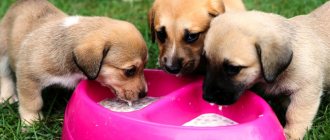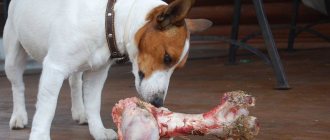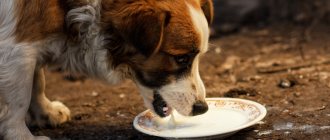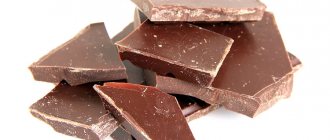Features of pork meat
In your pet’s diet, it is important to use only foods that are safe for health and contain essential vitamins and microelements. The addition of fatty components and offal can have different effects on the condition of the gastrointestinal tract. According to veterinarian nutritionists, the use of raw pork in nutrition has both negative and positive aspects.
Benefit
Piglet meat contains vitamins and microelements necessary for the proper development of the puppy. They have a beneficial effect on the functioning of the gastrointestinal tract and nervous system. B vitamins improve the condition of the coat and skin, and also maintain good eyesight for dogs. Lysine helps strengthen bones, increase the production of growth hormones and improve the pet's immune system.
Protein-rich foods increase metabolism and are involved in the formation of muscle tissue in the animal. Lean cuts contain 20 g of protein per 100 g of weight. Therefore, it will be useful for older animals and puppies to occasionally eat lean parts of piglets, which are easily digestible and become an excellent source of protein and vitamins.
Harm
Raw meat belongs to the high-risk category, as it may contain worm eggs and pathogenic bacteria that are transmitted from farm animals to domestic ones. Without processing, pork products will be simply dangerous.
If your four-legged friend has liver problems, then you should not give him fatty foods. It is also not suitable for obese individuals, because it contains a lot of cholesterol - this substance clogs the walls of blood vessels, which has a bad effect on the functioning of the cardiovascular system.
Dog diet
How the puppy that appears in the house develops and grows depends on what it is fed. Particular attention is paid to nutrition in the first year of a dog’s life. If the puppy does not receive the nutrients it needs, then problems may arise
, which will also affect his health. Fur, teeth, skeleton, and claws - all this is formed as a result of proper nutrition.
A puppy is the same child, only a dog, and therefore they feed it approximately the same (in terms of feeding frequency):
- after he began to eat on his own, that is, from the age of one and a half months to two, the puppy is fed every three hours;
- from two to three months the number of feedings begins to decrease from 6 to 5;
- then every two months the number of feedings decreases: at 4-5 months it is already 4 times, and at 6-7 months - 3 times a day;
- after the dog is one year old (you can even a couple of months later), feeding is carried out twice a day.
It is important not only the correct hourly feeding, but the correct diet.
Gradually, about once a week, you can add raw fish to your diet. It is better to give sea fish, as it is healthier and has fewer small bones. In addition, the risk of contracting worms comes from river fish.
A misconception is: “give the dog some milk.” Yes, milk contains both calcium and phosphorus. But milk also causes digestive problems, and not just in dogs. And phosphorus is absorbed from sea fish.
It might seem strange, but dogs can and should be given vegetables and fruits. First, the vegetables are given pureed.
, accustoming them to them from childhood. Vegetables and fruits contain many vitamins and also help the animal brush its teeth. When a dog chews a fruit or vegetable, it uses it to remove plaque from the teeth.
And of course, meat, as a high protein source, should be on the menu. Even if pork is completely excluded from the dog menu, beef and lamb should still be cooked.
Good nutrition is important to a dog's health. You should know that her digestive system features differ from humans. It is the dog's digestive process that does not allow him to be given pork.
Can pig meat cause illness?
Veterinarians explain why dogs should not eat pork due to the risk of developing dangerous illnesses. Fatty foods can cause serious illnesses that are difficult to treat in the future. Some of them are difficult to quickly diagnose, which subsequently leads to the death of the pet.
Here is a list of the main pathologies:
- Aujeszky's disease, or pseudorabies, which is caused by eating raw foods contaminated with bacteria. The disease develops rapidly and often ends in death.
- Nematodosis or toxocariasis, caused by worm larvae that have entered the quadruped. Spreading quickly, helminths multiply in all internal organs. Without timely treatment, the dog dies.
- Tapeworm attacks the central nervous system and can be fatal. The pathology is rare and therefore difficult to diagnose. However, treatment started on time gives good results.
- Trichinosis, which is caused by parasites that live in raw meat. They are able to live in the body for several years, causing harm to internal organs and destroying them. If the disease is not treated, the outcome will be disastrous.
All of these ailments develop due to the consumption of contaminated food that has not been cooked. Therefore, the presence of raw kibble in the diet can be dangerous for your four-legged friend.
Is heat treatment the solution?
Recently, there has been a tendency to reconsider the categorically negative attitude towards the question of whether it is possible to feed a dog pork. The value of the product is obvious, so the owner must decide for himself whether to include it in the four-legged menu. Heat treatment helps prevent parasite infestation.
Is it possible to give raw pork to dogs?
Heat-treated raw materials are not a safe product on a dog’s menu. Food will be poorly digested and become a source of dangerous bacteria and infections. In addition, from raw food you can become infected with worms that affect the internal organs of your pet. It is difficult for non-specialists to identify such an infection without additional tests, so feeding raw food can be dangerous to the health and life of your four-legged friend.
Is it possible to give dogs boiled pork?
This feeding option is considered by veterinarians to be the only acceptable one. The lean pieces are boiled, and if there are parts that are too fatty, the fat is cut off. In this case, food will not overload the liver and clog blood vessels with cholesterol. Food will be digested better if it is cut into small pieces. It is recommended to choose raw materials from piglets for nutrition.
It is recommended to give boiled pork no more than twice a week and only if the animal does not suffer from chronic obesity or has no problems with the cardiovascular system, liver, or kidneys.
An alternative is to scald finely chopped pieces of meat with boiling water before eating. This method is suitable if the owner has little time to cook.
Can a dog eat pork?
By giving a dog pork meat, we will not expose our pet to atherosclerosis - dogs simply do not get it! Therefore, they are not afraid of the high cholesterol content in this meat . In addition, pork fat is an excellent source of essential fatty acids, especially arachidonic acid. Of course, too much fat in a dog's diet will quickly make him obese. It can also cause diarrhea and even severe pancreatitis. Therefore, fatty pieces of pork meat can be given to a dog only periodically and in small quantities. However, like any other type of meat, pork can be a healthy addition to the diet of our carnivorous quadrupeds .
Pets, like people, are susceptible to trichinosis. Raw pork is not only a potential source of parasites. The domestic pig is an animal that can carry a disease that is completely harmless to humans, but completely fatal to dogs - pseudo-rabies, otherwise known as Aujeszky's disease .
Industrially produced pork is thoroughly tested. Therefore, the greatest risk comes from consuming dog meat from small farms or other unidentified sources. And unless we are sure that the meat we buy is completely safe, we should cook it before deboning it. Pork cooked this way, without additional salt or spices, is completely safe for dogs.
Pork offal and trimmings for dogs
Feeding meat and internal organs of a pig is allowed no more than twice a week. You should purchase only high-quality products that have passed veterinary inspection. It is not recommended to use pork products as the main diet
Lung, liver, heart and kidneys
By-products do not contain a large amount of fat, but at the same time they are very rich in vitamins and microelements. The introduction of pork heart, liver and lungs is beneficial for the dog: they will enrich the food with iron, zinc, amino acids and B vitamins.
Another plus is that they are inexpensive and can well diversify the diet of your four-legged friend. The main thing is that the insides are of high quality and subjected to heat treatment.
Salo
Lard is strictly contraindicated for dogs due to its high fat content. This raw material is not valuable for the body, but, on the contrary, can lead to dangerous obesity, problems with the cardiovascular system, liver and gastrointestinal tract.
Ears and skin
There is no clear opinion whether it is possible to give a dog pork skin and ears. These parts of the carcass can be dangerous to your pet's health due to helminths. In addition, they have little nutritional value. If the owner still decides to give the pet a skin and ears, then they must be heat treated.
Bones
Veterinarians strongly advise against giving pig and pig bones to pets. They have a tubular structure and break, forming sharp edges that can damage the dog's gums and teeth. In addition, bone fragments can cause suffocation by getting stuck in the larynx, or injure the esophagus, stomach, or intestines.
What should a dog owner remember?
Having learned about these diseases, any owner should understand why dogs should not eat pork. By the way, sometimes pork can be given to a dog. In winter, animals store fat to maintain temperature. lean pieces of pork once a week.
to your pet. At other times, it is allowed to give the heart and stomach of pigs to a dog.
Now many veterinarians are reconsidering their attitude to why pork is harmful to dogs. It is increasingly being said that lean pork is given as part of diets. Pork contains iron, zinc, amino acids, and B-group vitamins. This means that it can be given to dogs.
Knowing why it is impossible, everyone decides for himself and his animal what to give and in what capacity. High-quality lean and cooked meat can be given, but not overused.
In almost every article on feeding dogs, you can find a warning that feeding your four-legged friend this type of meat is not recommended. This is also confirmed by veterinarians, experienced breeders and dog breeders. Why should dogs not be given pork? What are the dangers of this product?
In addition, when eating pork, dogs are at risk of becoming infected with the herpesvirus Suid herpesvirus 1, which causes infectious bulbar palsy (Auessky's disease or pseudorabies). This disease is accompanied by severe itching in the area of the head and muzzle, and profuse salivation. Unfortunately for your pet, the disease is fatal in most cases.
Trichinosis is another serious pathology that awaits a dog who loves to eat pork. The disease causes diarrhea, abdominal pain, and fever.
Adding pork meat to industrial feeds
For pet owners who decide to give dry or wet commercial food, manufacturers have developed a balanced diet. In specialized stores you can purchase different types of food, including a line of food with pork.
Buyers are attracted by its high nutritional value, as well as the high content of macro- and microelements. A big advantage of use is its almost complete hypoallergenicity. The technology for the production of dry and wet industrial feed eliminates all the dangers associated with intestinal parasites and pathogenic bacteria. In addition, their fat content is precisely calculated, so food containing pork is completely safe.
What to do if your dog eats pork without permission?
All dogs, even domestic couch potatoes, are food lovers. Their gastrointestinal tract is genetically adapted to digest raw flesh. The owner should not worry about the fact that a naughty friend ate food that was forbidden to him without permission.
If a large amount of the wrong food was eaten, then on this day it is necessary to limit the prankster’s diet to low-fat and easily digestible foods. The diet can be extended for the next two days if the animal has eaten too much.
If symptoms of illness (nausea and vomiting, diarrhea, lethargy) appear, the four-legged glutton should be shown to a veterinarian.
Myths and their refutation
There is a lot of prejudice against pork on pet menus. However, the recommendations of experienced dog breeders and veterinarians refute some of them. Some of the most common misconceptions include:
- Poor digestibility. This is not true: the product is absorbed by the body no worse than veal, duck or chicken, second only to lamb.
- Increased fat content. Indeed, most of the pig carcass contains fat. However, you can choose lean cuts to feed, such as tenderloin or shoulder. They contain several times less fat than chicken.
- Low content of vitamins and microelements. On the contrary, all parts are rich in B vitamins, zinc, magnesium, phosphorus, copper and other substances necessary to maintain good health.
- Dangerous intestinal volvulus. It is not provoked by pork, but by excessive physical activity immediately after a hearty lunch.
- High cholesterol levels. This is true, but fatty fish and even chicken eggs can cause problems with blood vessels.
You should not be afraid to offer your pet pork-based food. The main thing is to observe moderation, use only high-quality and low-fat pieces for feeding, and subject them to heat treatment. You should not refuse to buy industrial feed, which contains pork processed according to all the rules.
Healthy Alternative: Beef and Poultry
Protein, necessary for the proper development of puppies and the maintenance of healthy adults, should be included in the diet of every animal. A useful substitute for pork in the diet is beef, veal or poultry. Their use will diversify the menu of a pet of any age and will be the key to excellent health.
The introduction of chicken, beef, and turkey into the puppy’s diet allows him to actively grow and strengthens the immune system. Proteins in the diet are easily digestible. Chicken, beef, veal and other varieties are served to the animal only after heat treatment.
Some owners refuse to use industrial and natural food if it contains pork. Most continue to consider this variety dangerous to the health of their four-legged friend. In fact, this is not so: lean parts of the carcass can diversify your pet’s diet and enrich it with everything necessary.
The article is of a recommendatory nature. Contact a specialist!
Food allergies in Yorkshire terriers
This breed is very allergic, so the following foods should be excluded from the dog’s diet:
- oatmeal and pearl barley;
- eggs;
- red meat;
- chocolate;
- dairy products;
- pork
Interesting: Why do dogs stick together during mating?
Terriers do not like the following fermented milk products:
- fermented baked milk;
- kafir;
- curdled milk.
Despite this, it is sometimes recommended to add cottage cheese to a dog’s diet. Yorkshire Terriers sometimes eat dried apricots, raisins and prunes. These products contain a lot of potassium, iron, manganese and vitamins, which help improve metabolic processes.
A few rules regarding nutrition.
- Food must be selected that is easily digestible, and minerals and vitamins must be given only in the correct proportions.
- If there is excess protein in the diet, the dog may develop kidney problems , and some may develop allergies.
- Not all dogs of this breed are allergic, so you need to select food yourself, based on the individuality of the dog’s body.
Looking at the Yorkie, it’s hard to imagine that this decorative and glamorous dog was once an excellent rat hunter. This breed is still distinguished by its liveliness, agility, courage and cheerfulness. Dog nutrition must be approached very responsibly : food that is suitable, for example, for divers and shepherd dogs, is absolutely not suitable for a miniature Yorkshire terrier, whose weight is only two or three kilograms. Dogs should be fed based on their individual needs.
We hope that we have helped answer the question of what to feed a Yorkshire terrier, and we will be glad to see you again on our project.











